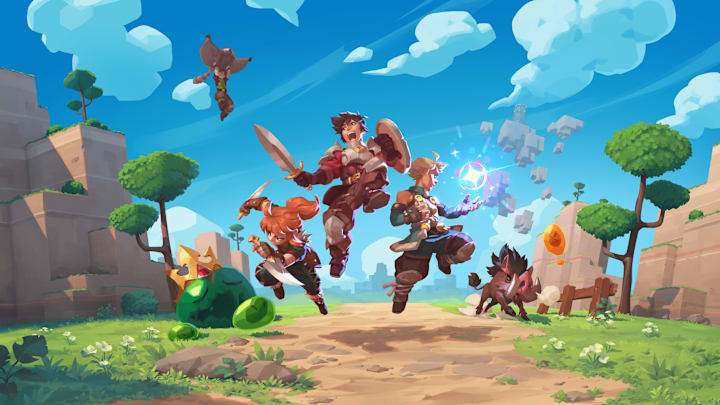Farever preview: A colorful co-op RPG with interesting ability mechanics
By Marco Wutz

Known for its accessible strategy games, Shiro Games is currently diversifying its portfolio with multiplayer automation game SpaceCraft and co-op open-world RPG Farever. Seeing both games back-to-back at Gamescom 2025 was an interesting contrast. Where the sci-fi title banks on visuals that are more inclined to reflect the real world, the RPG is colorful, blocky, and vibrant, purposely steering away from any sort of realism.
Farever isn’t the most original production for anyone familiar with the genre: You roam lands filled with enemies and dungeons, accept quests that drip-feed you some worldbuilding, and upgrade your abilities and equipment to become stronger.
Of course, Shiro Games has some ideas on how to make the formula a bit more unique. The world of Farever is quite vertical, introducing platforming elements. This is emphasized even further in some of the game’s dungeons, which are crafted to be themed challenges similar to the shrines players can encounter in The Legend of Zelda: Breath of the Wild. In this way, the traversal of the world becomes a challenge in itself and can further reward exploration — you will want to search every nook and cranny for hidden loot or other secrets as you jump, climb, and glide around. The fast travel points located in every region help you out by displaying the number of treasures and challenges in the vicinity.
While the blocky visuals might invite you to believe that the world is procedurally generated, it’s actually completely handcrafted — so if some corner intuitively looks like it holds a secret, there is a good chance that it does. “We want to reward players’ curiosity,” the developers tell me.
In typical RPG fashion, Farever features character classes. Again, though, there’s a fun twist. While you can level up your class and gain specific abilities from it, the main bulk of skills you can use in combat actually stem from your equipment. Every piece of gear is unique and has certain inherent abilities it can provide to its wielder. You can extract a limited amount of skills from weapons as well, allowing you to keep them around after switching to different gear. As a player, this allows for massive build flexibility and incentivizes experimentation (you can freely reset your class-based ability tree choices), exploration, and crafting. Because of course there has to be crafting.
That’s where the co-op aspect comes into play, because the system is very MMO-coded. You have to choose a job and actually level up your ability in this job to do certain tasks, like cook. Gathering basic resources is something anyone can do, provided they have the right tools. No mining ores without a pickaxe, for instance. As such, it enhances your own experience to bring in friends, who can cover jobs and activities unavailable to your own character. It creates strong dependencies between players, leading to friendly cooperation and deals. Since gear is restricted to one or several classes, trade is a pretty big deal. Find a cool bow, but you’re a warrior? Sell it to your archer buddy. That’s the goal, anyway.
“We don’t want the player to be like Gandalf, wielding a sword and having magic abilities,” the developers explain. That doesn’t mean that players can’t build a magic swordwielder. Warriors and wizards will share some gear and gain the same abilities from it, but their class-based kit will lead them to retain vastly different playstyles despite sharing some weapon options.
Combat works fairly typically: You have parry and dodge techniques, cooldown-based skills, some resource-based abilities, and your trusty basic attacks. It’s a tried and true system that immediately feels familiar, including the way enemies showcase attack patterns you can use against them. Difficulty scales depending on how many players are online.
As you explore further and defeat enemies, information like lore and even loot tables will be entered into your codex. The latter part is especially interesting, because it’s a bit oldschool. However, it certainly tracks with the developers’ goal of motivating players to go explore — if there’s some material you need, you’ll need to identify which monsters have it on their table, where to find these monsters, and how best to defeat them.
“We currently don’t plan on having a main quest,” the developers say. Players interested in the world will need to piece together information from their codex, collectible books, archaeological dig sites, and NPC conversations.
Anyone looking for an MMO-lite RPG might want to keep their eyes on this one.
Farever currently doesn’t have a release date, but is planned to come to PC.
More features on DBLTAP:
feed